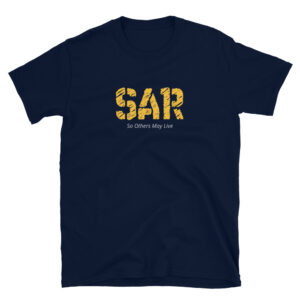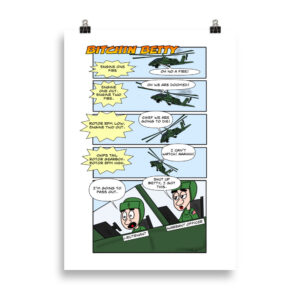Don't miss our flash to bang SALES!
WWII Veteran B-17 Flying Fortress Pilot Bill Merifield
 WWII Veteran B-17 Flying Fortress Pilot Bill Merifield
WWII Veteran B-17 Flying Fortress Pilot Bill Merifield
Question:And that’s going to be my first question is what’s your name, what was your branch of military and what was your rank?
Answer:At that time or now.
Question:During the war. Shall we start with that. My name is —
Answer:Okay. My name is Bill Merifield, my branch of service is United States Army Air Corps and my rank at that time was staff sergeant.
Question:How old were you when you enlisted?
Answer:Twenty, hm-hmm.
Question:So what was going on in the world when you enlisted?
Answer:Well, when I enlisted, this was — which was in February of 1942, this was two months after Pearl Harbor was bombed, and at that point I would say the world was preparing for war. And of course in Europe there had — the war had been going on since 1939, but the United States, because of our political beliefs, was attempting to support it logistically only. And then when we were bombed, at that given point, it became an active involvement all the way around.
Question:Do you remember what you were doing the day you enlisted?
Answer:Let’s see. The day I enlisted I was just — you know, I think I was on a picnic, come to think of it. Now, that’s — bear in mind the events of 53 years ago, at 77, become increasingly difficult to recall. So bear with me.
Question:Why did you enlist?
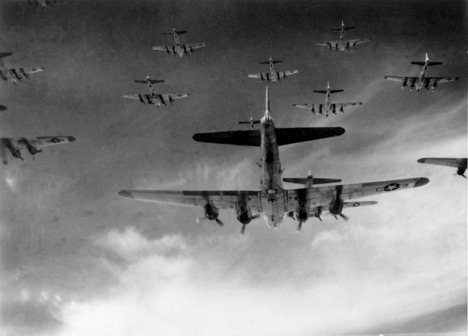 Answer:Well, I think essentially when you see your country attacked, you desire to participate in retaliation. I don’t think I had any high flying sentiments to be honest, and the only thing that I wanted to do — I had an opportunity to enlist and I would much rather fly, to be quite honest with you with flying pay and a comfortable living environment than participate in a ground war which is far less comfortable. That’s the honest reaction to it, really. And I flew privately. I had a private license before the war.
Answer:Well, I think essentially when you see your country attacked, you desire to participate in retaliation. I don’t think I had any high flying sentiments to be honest, and the only thing that I wanted to do — I had an opportunity to enlist and I would much rather fly, to be quite honest with you with flying pay and a comfortable living environment than participate in a ground war which is far less comfortable. That’s the honest reaction to it, really. And I flew privately. I had a private license before the war.
Question:Oh, really.
Answer:Yeah, so I flew quite a bit before the war.
Question:So when you enlisted, did you know you were going to war? Did you know you were going to be in battle?
Answer:Well, I assume, my desire to enter the military would be as a combatant. I mean I couldn’t see any point in behind the front lines duty, to be honest. And I wanted to fly. That’s something that I — I had been doing since I was a kid.
Question:So where did you go to boot camp, or did you go to boot camp?
Answer:Well, I went directly into — when I was a young individual I went into the California National Guards. I grew up in California although I’m a native here. And I lied about my age which was par for the course. So I think I was 15-1/2 when I went in the National Guards. And as a result of the National Guard experience, I already had what they would call basic training. So when I went into the Air Corps, I went right into flight school from there.
Question:So once you got in and you went to flight school, what was — what was your duty?
Answer:Well, principally it was — I was a student at gunnery school. Then I went to armament school. So essentially it was involved with learning to be a proficient gunner and also acquiring as much knowledge about the armament system, which was my responsibility.
Question:So at 20 were you old compared to the people around you, young, right in the middle?
Answer:I don’t know. I think — that’s sort of a subjective reaction. At that given point I grew up in San Francisco and I grew up to be, quite honest, in somewhat of a cultural activity. I grew up in the San Francisco Opera House and grew up exposed to classical music and that was largely my family activities. So I suppose — did that make me — I don’t know how to answer your question. Simply, that was my culture.
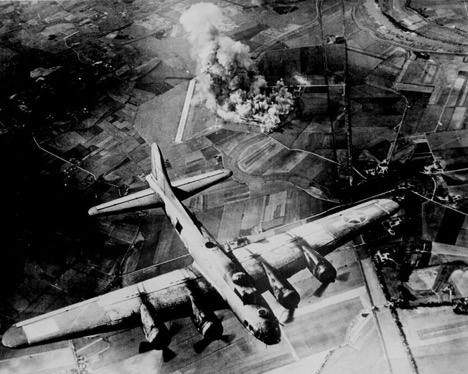 Question:So what — what’s your first memory of really facing — I mean you went through training, you did all that. And there had to be a point where all of a sudden you were in the war? What’s your memory of that?
Question:So what — what’s your first memory of really facing — I mean you went through training, you did all that. And there had to be a point where all of a sudden you were in the war? What’s your memory of that?
Answer:The first mission that I flew — going back — was over Kiel, Germany, and that was in 19 — that was 1943, I believe, that was in — probably in August if I’m not mistaken. I could be wrong on that. And we came back when that mission with about 800 holes at different parts of the aircraft and the trim tab shot out and my immediate reaction was I will never survive a tour. A tour is 25 missions, and my thought is I would never survive a tour. And while we’re on that, let me — let me bring up another point. Many times people ask, how many missions did you fly? It depends on where you were and what you were flying. So for example, medium bombers, which was shorter distance, had missions of anywheres from 35 to 50 to fly. When we went in it was 25, and Mr. Wally Hoffman who was — in my bomb group, flew 35 missions. So it depends where you were time wise in the war. Okay. But to get back to your question, when you count the holes, see the trim tab shot out, see a couple of your crew members wounded, worried about getting your gear down, whether you can land or not, that became very apparent to me after the first shot from a German airplane that, hey this is real. I mean they’re — they’re really shooting at me in a very lethal kind of way.
Question:What goes through your mind? When you’re up there? At that point?
Answer:As you’re being shot at?
Question:Yeah. I mean are you so busy doing other stuff that —
Answer:Oh, believe me, you’re afraid. You’re always afraid. You live with fear. Fear is part of it, part and parcel of it. When you’re in combat, you’re afraid. When you’re back in your barracks, you think of all the things that could have happened. And believe me, in an aircraft, a bomber, flying at 30,000 feet or thereabouts, in a relatively slow aircraft, many things could happen. But you developed a set of defense mechanisms where you sort of selectively, temporarily, forget. I think with the help of alcohol — a lot of us drank. Not when we were flying because air and alcohol don’t mix. You can’t do it. But when you’re not flying, away from combat, the only way I relaxed was fishing. And drawing. I like to sketch. I made quite a few sketches, and also I went to Albert Hall; there was some excellent musicals that I enjoyed going to. Ballet and opera and so on. And I read quite a bit.
Question:Now you flew in a —
Answer:B-17.
Question:Tell me about it.
Answer:Flying Fortress. You mean about the plane?
Question:Yours. The plane you flew in.
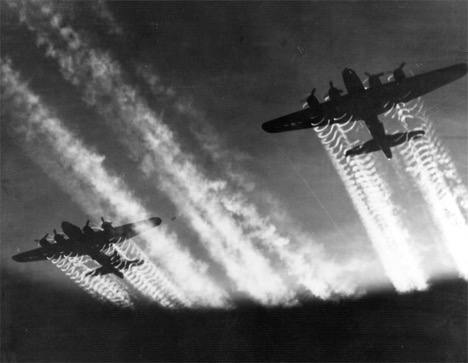
Question:Did she have a name?
Answer:Dottie J as I recall, Dottie J, yeah. And it — there isn’t much you can tell. It’s a fuselage about 76 feet long which 10 people carry on a strategic mission under the most uncomfortable conditions you can imagine. Beginning first with what you wear. And you — you dress for the environment in which you fight the war, which is high altitude. And a B-17, first, as we evaluate aircraft today, first was not pressurized. It was an open aircraft. And if you were a gunner back in the waist, the windows were open on the side so that you had direct prop wash coming through and temperatures anywheres from 40 to 60 below zero. I think that was the first thing. And you had on — getting ready for a mission. You wouldn’t believe it, it’s amazing. The first thing you had on was — I had two sets of long johns on. Then after we had sets of long johns, then I had a heated flying suit. Over the heated flying suit I had a pair of flight coveralls. Over the flight coveralls I had a pair of leather fleece lined pants, fleece lined boots and before I get into that, also, I had electrical – I had silk boots and then I had electrical heated boots which plugged into your flying suit. Then after we got all that on, then we had on a Mae West, which is a life preserver in case you go down, you have to ditch out over the water. And over that you have a parachute harness. We used chest chutes but we left the pack off because we had to put on a 65-pound flack suit. Then you have, oh, gloves, silk glove liners, then you have heated gloves, over that you have fur-lined mittens, then on top of that you’ve got your helmet and goggles, your throat mike, and then you have a metal helmet like the infantry uses, only they bump the sides out for your earphones. That weighs about as much as you do.
Question:So could you move?
Answer:Not with the speed that I would normally — that I would on the ground. (laughs) You could move, and you — yes, you could move. I think the biggest thing is that when you got into that situation, when you got up at high altitude, at 30,000 feet if you took your gloves off and touched anything, your hands would stick to it. So if you had a malfunction or whatever it is, you had to correct, you had to do it very, very carefully. And I think that — then periodically because we were breathing in an oxygen system, we had a bag hanging under our mask and there were two turrets with sponge rubber inside and when you breathed into that, the moisture would go into the sponge rubber and it would freeze solid, so if you didn’t pinch those turrets periodically, you would have anoxi
Answer:So anyway that was the environment and when you were flying as a gunner in the waist, you were standing up; you were not sitting down. There were no seats back in the waist.
Question:And so what — describe that are
Answer:
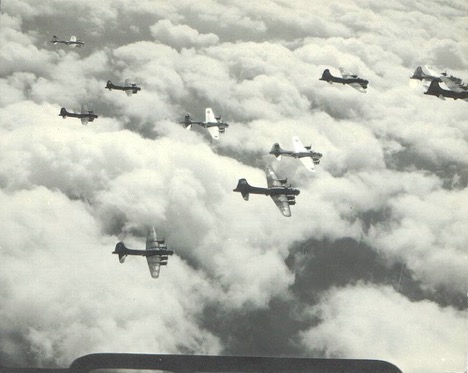
Then you get into other things. There’s — now for example, if you had to go to the bathroom, to be quite honest about it, I’m going to be very blunt. Do you wish me to do so? Usually you would urinate in a condom. And I suppose as a sort of an added joke, we would drop them out over the target area, refer to them as blivets. And the Germans probably would accuse us of bacteriological warfare, I’m sure. And we did the same thing. The big problem is if you had to go to the bathroom to eliminate all the way, if you had a one piece electrical suit which we had, you were in deep trouble. So later on they came out with a two-piece suit so you could at least, you know, lower the bottom half of it. But believe me, that was a very brief tour, and at that cold it was very brief. And any waste, you usually discarded it over the target.
Question:How long — I mean it varied, but when you took off, went up and did a mission and came back, an hour, two hours, half an hour?
Answer:Well you flew into the target area from England. You first have to cross the English Channel. Then you’ve got to build up altitude to whatever your bombing altitude is. And it may well take you hour and a half to two hour — but your rate of ascent is about 500 feet a minute with a full load of bombs it may take longer. But you had something even more than this to worry about. England, particularly, in the winter, the fall, even early spring, was inclement, and we’d have a great deal of ground fog. So when we took off, and our group, which was the 351st Bomb Group, by way of definition, when we took off as a group, we would take off through overcast. And we had no radar, we had no way of knowing actually where we were by radar impulse. We had no way of knowing. And so we took off into this and you could watch our group, for example, pull out of the clouds and occasionally you would see a glare in the clouds and a couple of B-17’s had collided. This was quite common. Okay, now, once you got in the air and you formed up in formation, depends on how many planes you had. And if you had, let’s say, for example, when I first started flying in ’43, we didn’t have those very large formations. Two hundred and fifty, in the early part of ’43, would be considered a maximum effort. Later on they got up to 500 and a thousand, a thousand planes. But getting up in that, forming up on your group, determining whether you’re going to be what they call high, high, or composite or low, it takes time to get all that formation organized. And then you have to cross the Channel, test fire your guns to make sure that they’re everything — your — your system defense is functioning. Then when you get over the target area the flak starts, generally at first, or we were met in ’43 — bear in mind we didn’t have P-51’s in 1943. And we had Royal Air Force took us across the Channel in Spitfires, but they didn’t have the fuel range, for example. It improved considerably after we got P-47’s. The only problem with P-47, in the air flying overhead providing an umbrella, looked dangerously like a Focke-Wulf 190. So you really had to be on your — the P-38’s were good. You could spot them because of the twin boom. But we — we didn’t have too many of them. Then after the P-47’s came, they gave us a longer range but after the P-51’s which I think were probably, the best of my knowledge, I think we started getting those in probably about January, February of ’44, and I could be wrong on dates, Karl, so please don’t hold me to it. But when they changed the engine on the P-51 to a Rolls-Royce Merlin and got rid of that Allison engine, then we had a tremendous, in fact they could take us to almost any target and back. So we — had — but after we started getting air superiority which was about that time — shortly after the P-51. But prior to that the Germans had air superiority. And often that — in ’43 that was our only escort. They flew all the way to — and it was a running battle. And Karl, bear in mind now, we’re not talking about jets. A jet which is Mach One, Mach 1.5 speed, we’re talking about 150 to maybe 165 miles an hour. And if you have a deep penetration, say for example, into — four hundred miles into Germany, you have to cross the Channel and do some fast mathematics at 150 miles an hour. Then after you drop your bombs you lighten up a bit but you may run into a head wind on the way out, and we lost a lot of planes over that period of time.
Question:What were the bombs that you had —
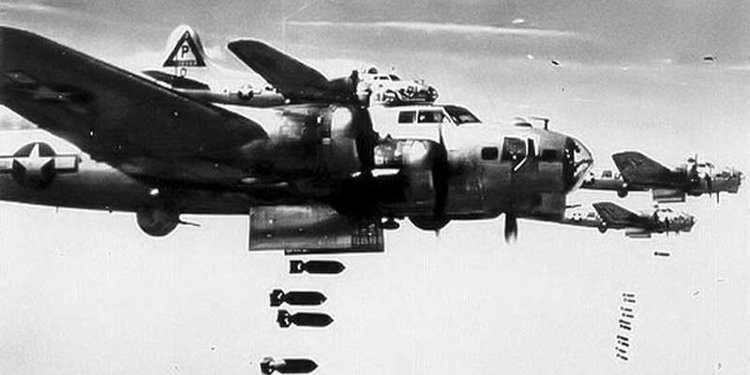
Question:And you wore headsets?
Answer:No, well, you had a head set, but to talk you had a throat mike.
Question:So who could you hear — when you were up there, who are you hearing? What are you hearing? What’s it sound like?
Answer:Well generally the pilot or somebody calling out. What you get, for example, if you’re under attack by enemy aircraft, what you’re getting is somebody calling out the planes. Now for example, whoever sees a plane, they call it out. Now for example, if it’s a plane coming in, to use the movie title Twelve O’clock High, that means that — using your
Check out Part II of Veteran Bill Merifield’s war stories and memories from World War II on The Frontlines
(Interview Courtesy of WWII Voices in the Classroom, www.wwiihistoryclass.com)
(Pictures Courtesy of the National Archives)
Popular Products
-
Fun Meter Mug
$12.50 – $17.00Select options This product has multiple variants. The options may be chosen on the product page -
SAR Line
$19.50 – $28.00Select options This product has multiple variants. The options may be chosen on the product page -
Bitching Betty Poster
$17.00 – $42.00Select options This product has multiple variants. The options may be chosen on the product page -
Wobbly One, WOJGy Bear Mug
$12.50 – $17.00Select options This product has multiple variants. The options may be chosen on the product page


